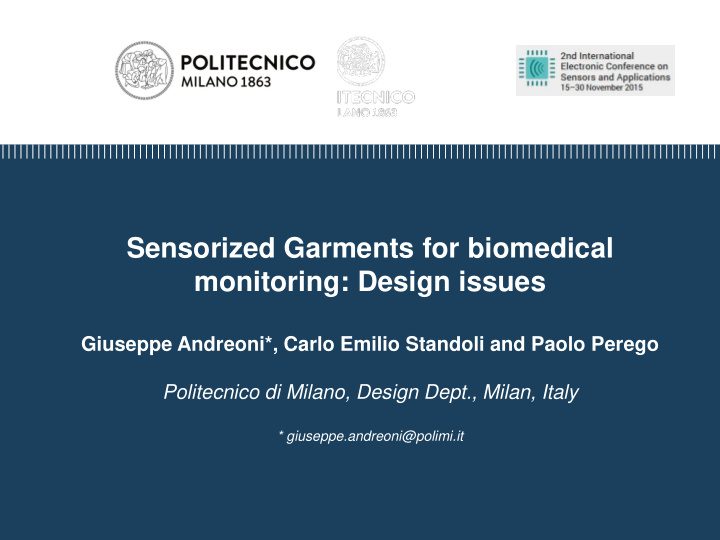



Sensorized Garments for biomedical monitoring: Design issues Giuseppe Andreoni*, Carlo Emilio Standoli and Paolo Perego Politecnico di Milano, Design Dept., Milan, Italy * giuseppe.andreoni@polimi.it
Introduction 2015-2025 decade: the “Wearable Era” 1.0 Wearables 2.0 Wearable Health Systems (WHS) or Wearable Biomedical Systems (WBS) are integrated systems on body-worn platforms wrist-worn devices or even biomedical clothes, offering pervasive non-invasive solutions for continuous health status monitoring of biomedical, biochemical and physical Main applications: Medicine, Life Style measurements. monitoring and Sport analysis (& fitness). Sensorized Garments for biomedical monitoring: Design issues
Introduction Generally it is thought that: making garments is very simple but for sensing garments, a great number of requirements are essentials: Technological specifications: sensors and actuators, materials, data communication (usually wireless), power supply and management, processing technique (onboard/on external devices, off line/real-time), algorithms for signal processing, … Physical and specifications: connectors, elasticity and adherence of the supporting platform (garments or belts, or adhesive patch or other) Usability specifications: GUI, washability and related stability of sensors, body positions and wearability (tasks, sensors, anthropometry…), elasticity and adherence of textiles, … Sensorized Garments for biomedical monitoring: Design issues
Goal This paper tries to discuss the most significant aspects to design a sensing wearable platform, in particular related to sensors for physiological signals monitoring. Designing wearable systems Two main specifications categories: - Technological : e.g. sensing principle and corresponding sensor implementation, materials and their properties, data transmission, power supply, processing and related algorithms; - Design : physical and design related factors such as anthropometry and gender issues, GUI, body positions and wearability, elasticity and adherence of the body fixing element or of the garments. Sensorized Garments for biomedical monitoring: Design issues
Method: measuring body signals WBS are an ideal platform for multi-parametric non-intrusive monitoring of health status, thus providing a remote primary and secondary prevention. They implement the following chain. Human as source of information (A), sensors (B) and their link (C) to measuring devices (D) and wireless data transmission (E).
Methods: measuring body signals What, where, how … All of these measures requires the sensor to be closely and firmly in contact with the body and without moving over the skin to avoid artefacts. Note. Movement is measured with miniaturized hardware system applied to each body district. Sensorized Garments for biomedical monitoring: Design issues
Methods: measuring body signals bioelectric signals: electrodes For bioelectric signals (e.g. ECG, EMG, and EEG) , sensors are electrodes. - The traditional adhesive Ag/AgCl electrodes placed directly onto the body in specific positions and with a connecting snap. - Textile electrodes (or Textrodes) belong to the polarized electrodes class; they are a textile structure constituted of electrically conductive yarns which may be used in direct contact with the skin. - Textrodes are made of textile yarns with electrical properties: - a) Metal yarns, i.e. yarns containing conductive fibers (stainless steel, copper or silver mixed with natural or synthetic fibers); - b) Yarns containing electro-conductive fibers (polymeric or carbon coated threads). Advantages: non-irritating the sking, embedded into standard clothes. Disadvantage is the poor skin/electrode contact. Sensorized Garments for biomedical monitoring: Design issues
Methods: measuring body signals bioelectric signals: electrodes Material for Textrodes Sensorized Garments for biomedical monitoring: Design issues
Methods: measuring body signals textile strain gage and force sensor implementation Sensorized Garments for biomedical monitoring: Design issues
Method: Designing sensorized garments Anthropometry is the discipline dealing with the measurement of physical features of the human body and their differences related to age, gender, lifestyle and ethnicity as inter- subject variability factors, or even time (from circadian to long period) and external environment as intra-subjective factors. Designing garments for man and woman have obvious different requirements for shape and fit not only for their different dimension but also for the daily task the users have to do. Basic Design criterion : « Several Sizes » Various sizes of a product are required to fit to the entire range of population. This is generally required for devices or personal items, which must conform more closely to the body as clothing. Sensorized Garments for biomedical monitoring: Design issues
Method: Designing sensorized garments Design issues: - Specific and modulated elasticity along the different part of the garment is needed to assure a good sensor-skin contact. Because of the intrinsic weakness of the bio-potentials measurable at the skin RA LA (0.5 – 2 mV), a close contact between electrodes and V1 skin is of major importance. It also minimize the LL RL movements of sensors over the skin during the recording to obtain a stable high quality signal . - For example to record the electrical activity of the heart, the elasticity of the garment should implement a close fitting of the suit around the thorax. - Modulated elasticity is obtained by proper choice of elastic yarns and/or by design, and they determine also comfort and wearability of the garments itself. - Wearability is crucial for weak users for autonomous operations, and repeatable sensors inter-session repositioning to achieve a reliable monitoring. Sensorized Garments for biomedical monitoring: Design issues
Design guidelines Gemperle et al. analyzed the wearability requirements for hardware systems that have been formalized in a 13-points guideline Sensorized Garments for biomedical monitoring: Design issues
Conclusions WBS are an ideal platform for multi-parametric non-intrusive monitoring of health status, thus providing a remote primary and secondary prevention. In this paper we have presented some issues related to the design of these systems with specific reference to technological and human factors requirements. One critical issue that it is under research and development is the integration of textile with flexible electronics for a complete embedded system. This allows to match the methodological approach pursued by wearable systems: non intrusiveness, i.e. a process that does not affect user behavior and is completely transparent to him/her during his/her own daily activities. Only in this case we will obtain actual wearable 2.0 generation system for our health.
Thank you Contacts: Giuseppe Andreoni Design Dept. Politecnico di Milano e-mail: giuseppe.andreoni@polimi.it Sensorized Garments for biomedical monitoring: Design issues
Recommend
More recommend